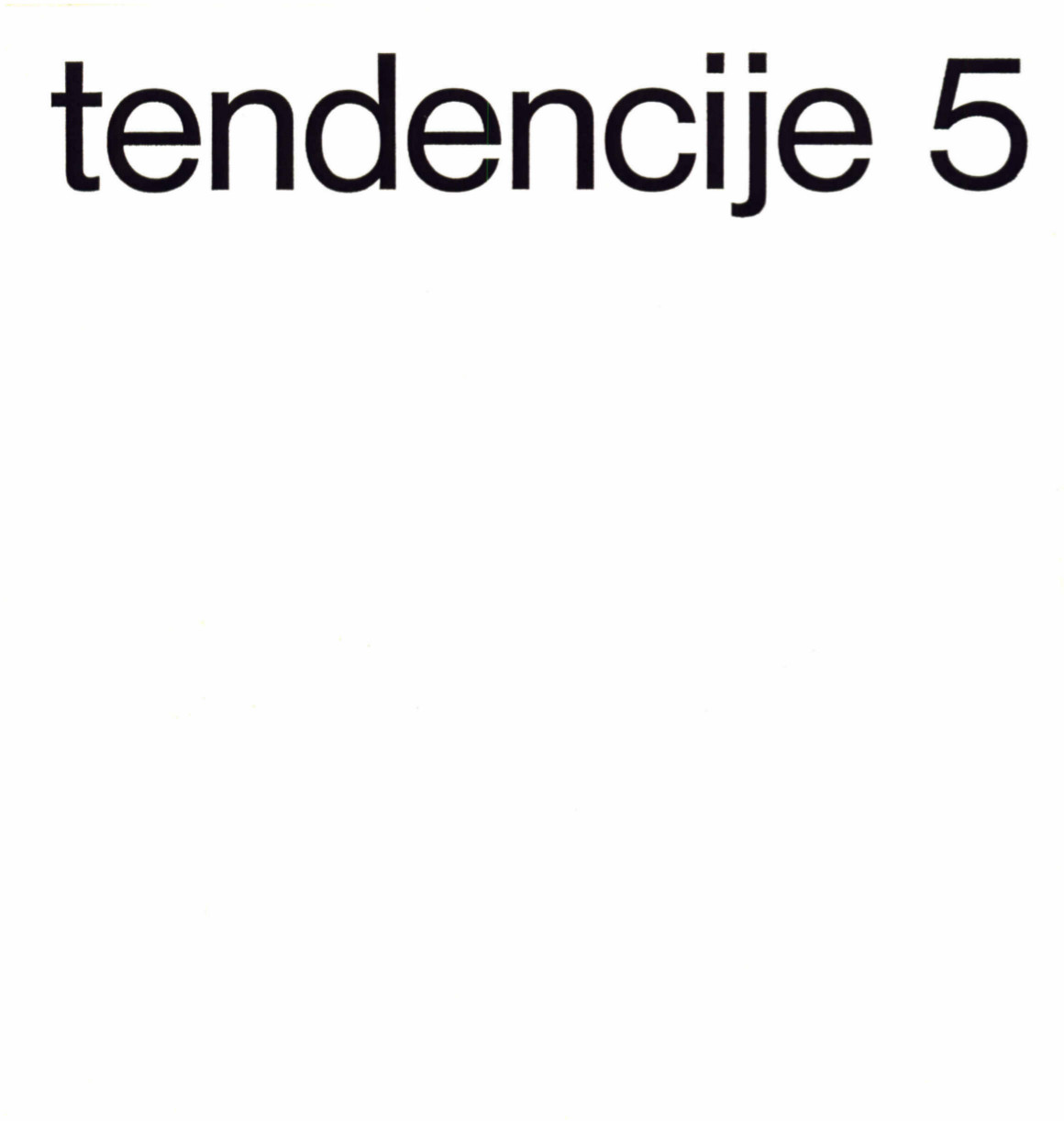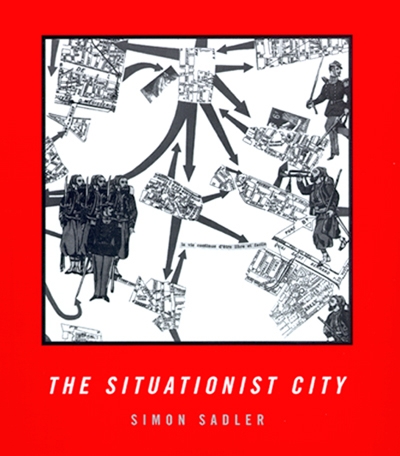Tendencije / Tendencies, 2, 4, 5 (1963-73) [SC, FR, DE, IT, EN]
Filed under book | Tags: · art, computer art, conceptual art, design, kinetic art, op art



Catalogues of the exhibition series New Tendencies held in Gallery of Contemporary Art, Zagreb.
Nove tendencije 2
Texts by Matko Meštrović and Radoslav Putar.
Publisher Galerija suvremene umjetnosti, Zagreb, 1963
[68] pages
Tendencije 4 / Tendencies 4: Zagreb, 1968-1969
Edited by Boris Kelemen and Radoslav Putar
Texts and statements by Radoslav Putar, Almir Mavignier, Matko Meštrović, Enzo Mari, Alessandro Carlini, Bernhard Schneider, Alberto Biasi, Gianni Colombo, Milan Dobeš, Herbert W. Franke, Karl Gerstner, Rolf Glasmeier, Rolf Gravenhorst, Hein Gravenhorst, Dieter Hacker, John Gabriel Harries, Gottfried Jäger, Richard Kriesche, Max H. Mahlmann, Marcello Morandini, Zoran Radović, Bernhard Sandfort, Paolo Scheggi, Klaus Staudt, Josef Hermann Stiegler, Jorrit Tornquist, Gabriele de Vecchi, Herman de Vries.
Publisher Galerija suvremene umjetnosti, Zagreb, 1970
[146] pages
Tendencije 5 / Tendencies 5
Edited by Božo Bek, Boris Kelemen and Marijan Susovski
Texts by Radoslav Putar, Božo Bek, Boris Kelemen, Marijan Susovski, Nena Dimitrijević.
Publisher Galerija suvremene umjetnosti, Zagreb, 1973
[137] pages
Nove tendencije 2 (SC, 1963, 63 MB)
Tendencije 4 / Tendencies 4: Zagreb, 1968-1969 (SC/FR,DE,IT,EN, partial scan, 1970, 17 MB)
Tendencije 5 / Tendencies 5 (SC/EN, 1973, 55 MB)
Franco Berardi: Contro il lavoro: lo sviluppo al capitale il potere agli operai (1970) [Italian]
Filed under book | Tags: · autonomy, capitalism, ideology, labour, work

“Questo lavoro vuole essere un primo tentativo di costruire sia pure in modo tutto provvisorio, tutto legato alla insorgenza di nuove possibilità ed indicazioni anche teoriche, una impostazione che, partendo dal punto di vista capitalistico, dalla demistificazione dell’ideologia, della scoperta, al di sotto dell’ideologia, dello sviluppo reale del capitale, giunga a decifrare in termini di progetto strategico l’emergenza dei livelli di composizione operaia.
Tutto quello che vi è in questo saggio manifesta la sedimentazione progressiva di ipotesi e linee teoriche legate a situazioni che oggettivamente crescono: e non si può fissare un livello in modo astratto, come ottimale; ma la linea strategica, per non trasformarsi in ideologia, va vista come articolazione teorica del livello pratico delle lotte, che cresce col loro crescere, e non si ferma e fissa ad un livello ottimo. In questo senso i dislivelli (percepibili persino nel linguaggio) rappresentano la crescita di un discorso come articolazione teorica della crescita pratica delle lotte dell’autonomia, dell’organizzazione.”
Publisher Edizioni della Libreria, Milan, 1970
161 pages
via Silvio
PDF (30 MB)
Internet archive (version cleaned by Grafton9, added on 2017-9-6)
Simon Sadler: The Situationist City (1998)
Filed under book | Tags: · architecture, city, design, situationists, urbanism

“From 1957 to 1972 the artistic and political movement known as the Situationist International (SI) worked aggressively to subvert the conservative ideology of the Western world. The movement’s broadside attack on “establishment” institutions and values left its mark upon the libertarian left, the counterculture, the revolutionary events of 1968, and more recent phenomena from punk to postmodernism. But over time it tended to obscure Situationism’s own founding principles. In this book, Simon Sadler investigates the artistic, architectural, and cultural theories that were once the foundations of Situationist thought, particularly as they applied to the form of the modern city.
According to the Situationists, the benign professionalism of architecture and design had led to a sterilization of the world that threatened to wipe out any sense of spontaneity or playfulness. The Situationists hankered after the “pioneer spirit” of the modernist period, when new ideas, such as those of Marx, Freud, and Nietzsche, still felt fresh and vital.
By the late fifties, movements such as British and American Pop Art and French Nouveau Ralisme had become intensely interested in everyday life, space, and mass culture. The SI aimed to convert this interest into a revolution—at the level of the city itself. Their principle for the reorganization of cities was simple and seductive: let the citizens themselves decide what spaces and architecture they want to live in and how they wish to live in them. This would instantly undermine the powers of state, bureaucracy, capital, and imperialism, thereby revolutionizing people’s everyday lives.
Simon Sadler searches for the Situationist City among the detritus of tracts, manifestos, and works of art that the SI left behind. The book is divided into three parts. The first, “The Naked City,” outlines the Situationist critique of the urban environment as it then existed. The second, “Formulary for a New Urbanism,” examines Situationist principles for the city and for city living. The third, “A New Babylon,” describes actual designs proposed for a Situationist City.”
Publisher MIT Press, 1998
ISBN 9780262193924
ix+233 pages
via heimitokunst, ¯\_(ツ)_/¯
Reviews: Andrew Hussey (LRB, 1999), Notbored (n.d.), Andy Merrifield (Harvard Design Mag, 2000), Rosemary Wakeman (French Polit Cult Soc, 2000), James L. Penner (TDR, 2001), Sarah Deyong (J Society Arch Hist, 2001), Benedict Seymour (Mute, 2004), Natasha Gershfield (Manchester School Arch, 2010).
Comment (0)
